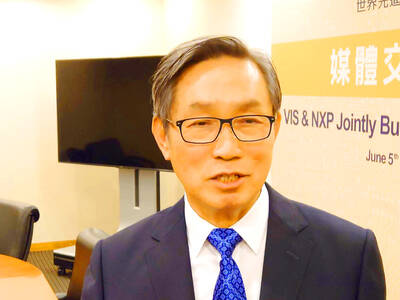A Ministry of Economic Affairs official yesterday defended the government’s offshore wind power policy and its decision to lower the feed-in tariff (FIT) rate, but a local company executive said the FIT scheme could undermine the nation’s offshore wind industry.
Speaking at a forum on the prospects and challenges facing Taiwan’s offshore wind sector, Deputy Minister of Economic Affairs Tseng Wen-sheng (曾文生) said that the FIT scheme is not the only factor affecting the industry’s development.
The industry’s success also has to do with the nation’s economic, financial, industrial and legal environment, Tseng said, expressing the hope that contractors would not solely focus on the FIT rate.
The ministry, which is scheduled to finalize the rate tomorrow, angered foreign contractors in November last year when it proposed setting the FIT for wind power at NT$5.1 per kilowatt-hour (kWh) this year, down 12.71 percent from NT$5.8 per kWh last year.
The move has prompted Denmark’s Orsted A/S to suspend its two offshore wind projects in Taiwan.
However, Tseng said that the ministry has been working over the past year to establish the economic, financial and industrial conditions, as well as a legal framework, favorable for companies looking to develop wind farms.
“For the offshore wind industry to flourish, there is a need to strike a balance among many issues involving these four variables,” Tseng said.
In a presentation at the forum, China Steel Corp (中鋼) executive vice president Wang Shyi-chin (王錫欽) said that he agreed with Tseng’s view that the FIT is not the only determining factor for the industry’s development.
However, it is a decisive factor, said Wang, whose company is part of a consortium with Copenhagen Infrastructure Partners and Mitsubishi Corp subsidiary Diamond Generating Asia Ltd that was formed in 2017 to develop offshore wind farms in Taiwan.
The Bureau of Energy, which proposed the lower FIT rate, has underestimated the costs associated with building an offshore wind farm, Wang said.
The cost of building such a wind farm in the US is NT$370 million (US$12 million) per megawatt of installed generating capacity, which is 3.5 times higher than the cost in European nations, where offshore wind power is a maturing industry, he said.
However, even in the UK, where offshore wind power generation is advanced, the FIT was kept in a range of NT$5.47 to NT$7.5 per kWh for 15 years before tenders were introduced to replace the FIT scheme in 2015, Wang said.
France, which benefits from the resources of its neighbors, nonetheless estimated the cost of two offshore wind farms set for completion in 2021 and 2022 at NT$181 million per megawatt, he said.
The FIT rate proposed by the ministry was based on a cost of NT$155 million per megawatt, even lower than the cost in France, and also below the estimated cost of NT$227 million for a demonstration project in Changhua County, which Taiwan Power Co (台電) hopes to complete next year, Wang said.
Without an FIT scheme that offers a reasonable rate of return for the companies involved, Taiwan could miss out on the opportunity to become a leader in the Asia-Pacific region in this field, he added.

STEEP DECLINE: Yesterday’s drop was the third-steepest in its history, the steepest being Monday’s drop in the wake of the tariff announcement on Wednesday last week Taiwanese stocks continued their heavy sell-off yesterday, as concerns over US tariffs and unwinding of leveraged bets weighed on the market. The benchmark TAIEX plunged 1,068.19 points, or 5.79 percent, to 17,391.76, notching the biggest drop among Asian peers as it hit a 15-month low. The decline came even after the government on late Tuesday authorized the NT$500 billion (US$15.2 billion) National Stabilization Fund (國安基金) to step in to buoy the market amid investors’ worries over tariffs imposed by US President Donald Trump. Yesterday’s decline was the third-steepest in its history, trailing only the declines of 2,065.87 points on Monday and

TAKING STOCK: A Taiwanese cookware firm in Vietnam urged customers to assess inventory or place orders early so shipments can reach the US while tariffs are paused Taiwanese businesses in Vietnam are exploring alternatives after the White House imposed a 46 percent import duty on Vietnamese goods, following US President Donald Trump’s announcement of “reciprocal” tariffs on the US’ trading partners. Lo Shih-liang (羅世良), chairman of Brico Industry Co (裕茂工業), a Taiwanese company that manufactures cast iron cookware and stove components in Vietnam, said that more than 40 percent of his business was tied to the US market, describing the constant US policy shifts as an emotional roller coaster. “I work during the day and stay up all night watching the news. I’ve been following US news until 3am

Six years ago, LVMH’s billionaire CEO Bernard Arnault and US President Donald Trump cut the blue ribbon on a factory in rural Texas that would make designer handbags for Louis Vuitton, one of the world’s best-known luxury brands. However, since the high-profile opening, the factory has faced a host of problems limiting production, 11 former Louis Vuitton employees said. The site has consistently ranked among the worst-performing for Louis Vuitton globally, “significantly” underperforming other facilities, said three former Louis Vuitton workers and a senior industry source, who cited internal rankings shared with staff. The plant’s problems — which have not

TARIFF CONCERNS: The chipmaker cited global uncertainty from US tariffs and a weakening economic outlook, but said its Singapore expansion remains on track Vanguard International Semiconductor Corp (世界先進), a foundry service provider specializing in producing power management and display driver chips, yesterday withdrew its full-year revenue projection of moderate growth for this year, as escalating US tariff tensions raised uncertainty and concern about a potential economic recession. The Hsinchu-based chipmaker in February said revenues this year would grow mildly from last year based on improving supply chain inventory levels and market demand. At the time, it also anticipated gradual quarter revenue growth. However, the US’ sweeping tariff policy has upended the industry’s supply chains and weakened economic prospects for the world economy, it said. “Now